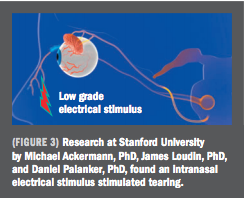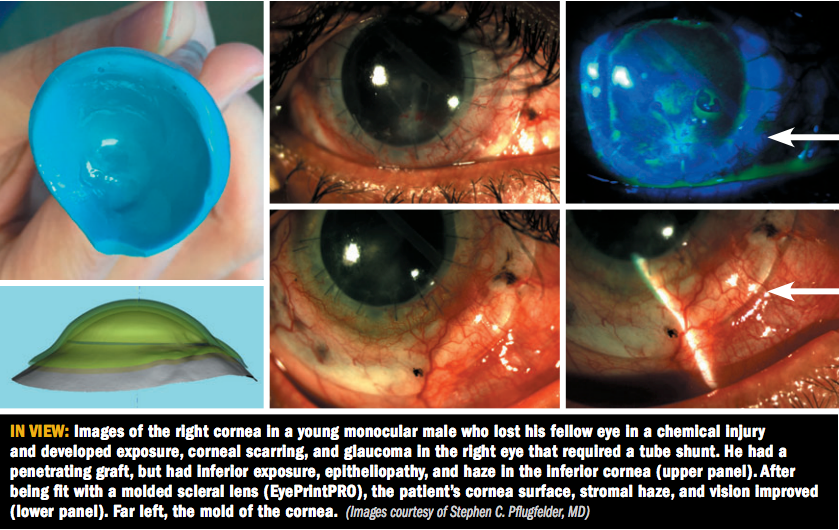Article
Dry eye strategies from lab to clinic
Author(s):
Management evolves from nasal neurostimulation, prosthetic replacement of ocular surface ecosystem



New devices and technology continue to flow from the lab to the ophthalmology practice, radically changing the management or conceal of ocular surface diseases. Nasal neurostimulation is among the newest strategies and has been shown to increase production of natural tears
Reviewed by Stephen C. Pflugfelder, MD
New approaches with novel devices and technologies for dry eye disease continue to flow from laboratory to ophthalmic practice, radically changing the management or conceal of ocular surface disorders, said Stephen C. Pflugfelder, MD.
Consider how scleral lenses have revolutionized the therapy of cornea and ocular surface diseases and improved corneal transplant outcomes, with new solutions continuing to emerge, said Dr. Pflugfelder, professor and holder of the James and Margaret Elkins Chair in Ophthalmology, Baylor College of Medicine, Houston.
Due largely to the pioneering work of the late Perry Rosenthal, MD, in the 1990s, scleral lens technology was modernized to create seamless inner and outer lens surfaces as well as optimize the corneal vault and maintain a fluid-filled reservoir.
These improvements, in turn, expanded therapeutic indications to encompass vision correction for irregular corneas as well as protection and hydration in various eye diseases, according to Dr. Pflugfelder.
More recent advances include:
- greater array of materials with Dk values ranging from 80 to 143 and increased wettability of the coatings;
- more options for pre-fabricated lenses;
- innovative custom designs; and
- expanded therapeutic indications, such as extended wear for non-healing epithelial defects and neurotrophic ulcers and use of these devices to deliver antibiotics, corticosteroids, and blood products.
Complex corneal cases
One advance in prosthetic scleral device technology-prosthetic replacement of the ocular surface ecosystem (BostonSight PROSE)-has changed the management of many ocular surface diseases, Dr. Pflugfelder said.
He highlighted several cases in which the treatment was effectively used, such as a patient with congenital seventh nerve palsy and exposure keratopathy, and another patient with a non-healing neurotrophic epithelial defect following herpes zoster that recurred despite three amniotic membrane transplants but healed in about 1 month after the patient began wearing a scleral contact lens and has remained healed.
Other cases include that of a patient with probable trachoma with superior tarsal scarring and limbal stem cell dysfunction. After the eye was fitted with a scleral lens, the migratory epitheliopathy from the scarred upper lid was replaced with a smooth corneal epithelium, and acuity improved from 20/100 to 20/40.
In a fourth case, an international patient with a cicatricial disease and hand-motion visual acuity bilaterally began wearing a scleral device filled with autologous platelet-rich plasma.
In just 9 months, his corneas cleared significantly, and the patient now has functional visual acuity. Another new technology uses a three-dimensional model of the eye to fabricate a lens that matches the contours of the patient’s cornea and sclera (EyePrintPRO, EyePrint Prosthetics).
“We now have the ability…to fit difficult eyes like those with filtering blebs,” he said.
Dr. Pflugfelder turned to this transparent prosthetic scleral device for a patient who had monocular vision following a chemical injury. Treatment had included a tube shunt and a scleral patch graft inferiorly, but the epithelium kept breaking down. Ultimately, this device was successfully placed over the scleral patch.
The prosthetic scleral cover was also utilized in a patient with Stevens-Johnson syndrome who had undergone therapeutic penetrating keratoplasty and implantation of a superior tube shunt. When a scleral lens impinged on the temporal conjunctiva, a colleague of Dr. Pflugfelder’s fitted the prosthetic scleral cover over the tube shunt, resulting in a much more comfortable outcome.
Neurostimulation
Nasal neurostimulation is one of the newest strategies for managing dry eye, Dr. Pflugfelder said. “It’s been known that Schirmer test combined with nasal stimulation can stimulate reflex tearing, and if we anesthetize the nostrils there’s about a 34% decrease in tear production in normal subjects,” he said.
Neural signaling of tear secretion may be disrupted in dry eye by corneal anesthesia, anticholinergic medications, autoantibodies to acetylcholine receptors, inflammatory cytokines, and lymphocytic infiltration of the lacrimal gland, and reflex tearing may be lost due to conditions such as Sjögren’s syndrome, Stevens-Johnson syndrome, graft versus host disease, and trigeminal nerve damage.
Searching for ways to stimulate natural tear production, Stanford University researchers found that a low-grade intranasal electrical stimulus could initiate the reflex loop and cause lacrimal secretion. This finding led to the development of what is now known as the TrueTear device (Allergan), included in the company’s 2015 acquisition of Oculeve.
By inserting the disposable silicone nasal prongs on this small rechargeable device, patients can temporarily increase tear production in the inferior tear meniscus. This approach also gives patients more control of their therapy, Dr. Pflugfelder said.
Evidence supporting the concept of nasal stimulation includes an open-label pilot study of 40 patients who used the nasal stimulator 4 times a day for 180 days. Improvement in clinical signs and symptoms, such as increased tear production and decreased irritation symptoms, continued up to six months. Dr. Pflugfelder also noted that in addition to stimulating aqueous tear production, the neurostimulation device increases conjunctival goblet cell degranulation.
Disclosures:
Stephen C. Pflugfelder, MD
P: 713/798-4732 E: stevenp@bcm.edu
This article was adapted from Dr. Pflugfelder’s presentation during Cornea Subspecialty Day at the 2018 meeting of the American Academy of Ophthalmology. Dr. Pflugfelder is a consultant/advisor to Allergan, Senju, and Shire. He has also received grant support from Shire.
Newsletter
Don’t miss out—get Ophthalmology Times updates on the latest clinical advancements and expert interviews, straight to your inbox.





